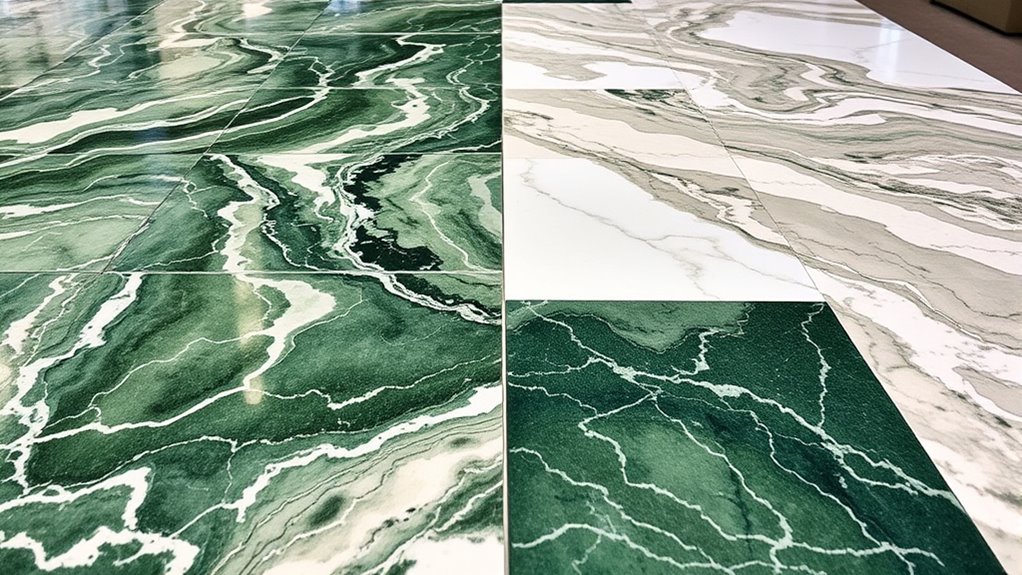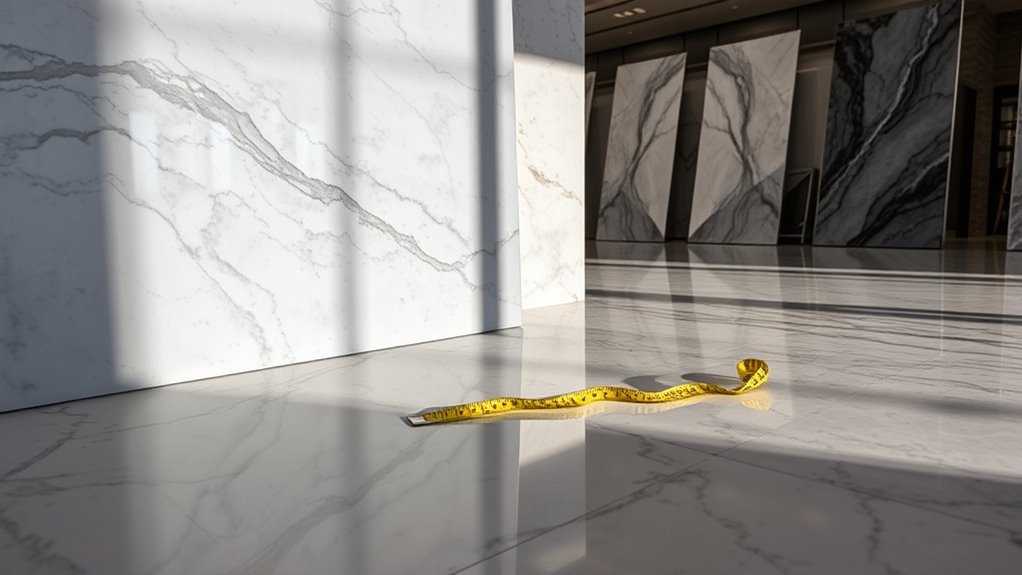Your marble flooring cost hinges on several key factors: the type and quality of marble you choose, its origin and rarity, and the size and thickness of tiles. Installation complexity and surface finish also play roles, alongside labor rates and any subfloor prep needed. Don’t forget additional materials like trims, ongoing maintenance, sealing requirements, and accessibility for delivery. Each aspect shapes your budget and project scope intricately. Explore further to grasp how these elements interact and influence your investment.
Type and Quality of Marble

Marble variety plays a crucial role in determining flooring costs, as different types offer distinct characteristics in color, veining, and durability. When you select marble types, you’ll notice how Carrara, Calacatta, and Statuario each bring unique aesthetics and price points due to their composition and appearance. Quality grades further influence cost; higher-grade marble typically features fewer imperfections, consistent veining, and superior polishability. As you evaluate marble types, consider how the grade reflects structural integrity and longevity, directly impacting maintenance and lifespan. By understanding the precise differences in marble types and quality grades, you gain freedom to make informed choices that balance budget, style, and durability. This analytical approach guarantees your marble flooring investment aligns perfectly with your vision and functional needs.
Origin and Rarity of the Marble
When choosing marble, you’ll find that its country of origin greatly influences cost due to factors like extraction methods and local demand. Rare marbles from specific regions tend to command higher prices because their limited availability drives exclusivity. Understanding these elements helps you anticipate how origin and rarity affect your overall flooring investment.
Country of Marble Origin
Although the visual appeal of marble is universal, the country where it’s quarried greatly influences its cost due to factors like extraction difficulty, transportation, and the stone’s rarity. When sourcing marble, you’ll need to take into account stringent marble export regulations that vary widely by country, affecting availability and price. Additionally, marble import tariffs imposed by your country can greatly increase the final cost, especially for stones from distant or politically sensitive regions. Transporting heavy marble slabs over long distances adds logistical expenses, which you’ll ultimately pay for. Countries with well-established marble industries often have streamlined processes, reducing costs, while those with limited infrastructure or strict export controls can drive prices higher. Understanding these nuances helps you make informed decisions, ensuring you get the best value without compromising on quality or style.
Marble Rarity Impact
Since the rarity of a stone directly influences its market value, you’ll find that marbles sourced from limited or unique geological formations command higher prices. When you explore marble rarity impact, understanding marble sourcing trends is essential—they reveal which quarries are depleting and which rare varieties are emerging. These trends, combined with global market fluctuations, affect availability and cost. For example, marbles like Calacatta or certain exotic types are pricier due to scarce deposits and high demand. If you want freedom in design choices without overspending, you should monitor how rarity shapes pricing. By aligning your project timeline with these market patterns, you can secure rare marble at a more favorable rate, balancing uniqueness with budget constraints effectively.
Size and Thickness of the Tiles

Choosing the right size and thickness of marble tiles plays a critical role in determining your flooring costs. Tile dimensions directly influence material usage and installation time, impacting your budget. Thickness variations also affect durability and price, with thicker tiles generally costing more due to increased material demand.
Consider these factors:
- Larger tile dimensions reduce grout lines but may increase waste and handling difficulty.
- Smaller tiles offer design flexibility but can raise labor costs due to more cuts.
- Thicker tiles provide enhanced longevity but come with higher material and shipping fees.
- Thinner tiles lower costs but might require extra subfloor preparation to prevent damage.
Complexity of the Installation Pattern
Beyond tile size and thickness, the pattern you select for your marble flooring greatly influences both the installation process and overall cost. The installation design’s pattern complexity dictates the amount of cutting, fitting, and alignment required. Simple layouts like straight or diagonal grids demand less labor and time, keeping costs lower. However, intricate patterns—such as herringbone, basketweave, or custom mosaics—require precise measurements and more skilled craftsmanship, increasing installation time and expense. You’ll also need to take into account waste factor; complex patterns often generate more offcuts, meaning you might need to purchase additional marble to compensate. Ultimately, if you value freedom in design, be prepared for higher costs linked to advanced pattern complexity, as the installation design’s intricacy directly impacts labor intensity and material usage.
Surface Finish and Treatment

You’ll find that the type of surface finish greatly influences both the look and cost of your marble flooring. Choosing between honing and gloss affects the level of polish and maintenance required, while sealing treatments provide essential protection against stains and wear. Understanding these elements helps you make informed decisions about durability and aesthetic preferences.
Polishing Techniques Impact
Although marble flooring’s base cost depends on material and installation, the polishing technique you select greatly influences both the final appearance and durability of the surface. Different polishing methods and polishing tools can transform the marble’s texture, sheen, and resistance to wear.
Here’s what to evaluate:
- Mechanical Polishing: Uses diamond abrasives for a high-gloss finish, increasing cost but enhancing durability.
- Chemical Polishing: Involves acids to smooth the surface; less costly but may reduce longevity.
- Hand Polishing: Labor-intensive with variable results; gives you control but often raises expenses.
- Machine Buffing: Balances cost and finish quality using rotary tools; ideal for moderate budgets seeking shine.
Choosing the right polishing technique lets you tailor your marble’s look and lifespan without compromising freedom in style or budget.
Sealing and Protection
The polishing technique you choose sets the stage for how your marble flooring will respond to sealing and protection methods. Depending on the finish, you’ll need specific sealing methods to maintain the stone’s integrity. Penetrating sealers are ideal for polished marble, as they absorb into pores without altering the surface, preserving natural sheen while providing stain resistance. Conversely, honed or matte finishes often benefit from topical protective coatings, which form a durable layer shielding against wear and moisture. When selecting sealing and protective coatings, consider factors like foot traffic, exposure to spills, and cleaning frequency. Proper application extends your marble’s lifespan and appearance, reducing maintenance costs. By tailoring sealing methods to your marble’s finish and usage, you guarantee lasting protection without compromising its aesthetic freedom.
Honing Versus Gloss
Two primary surface finishes—honing and gloss—significantly influence both the appearance and maintenance requirements of marble flooring. Honing techniques produce a matte, smooth surface that minimizes glare and hides scratches, making it ideal if you want subtle elegance with less upkeep. Gloss finishes, on the other hand, create a shiny, reflective surface that enhances marble’s natural veining but demands more frequent polishing to retain its luster.
Consider these factors when choosing:
- Durabilidad: Honed surfaces resist wear better in high-traffic areas.
- Mantenimiento: Gloss finishes require regular polishing.
- Aesthetic: Honing offers understated beauty; gloss provides dramatic, bright appeal.
- Costo: Gloss finishes often increase initial and ongoing expenses due to maintenance.
Choosing between honing and gloss finishes directly impacts your flooring’s longevity and your freedom from constant care.
Labor Costs in Your Location
Where you live plays an essential role in determining labor costs for marble flooring installation. Labor rates fluctuate considerably due to the local market’s economic conditions and demand for skilled tile setters. Regional differences impact wage expectations—urban centers often command higher prices compared to rural areas, where labor might be more affordable. Additionally, the availability of experienced professionals in your area can influence costs; scarce expertise drives prices up. You should also consider local licensing requirements and labor laws, which might add to the overall expense. Understanding these factors helps you anticipate realistic labor cost estimates rather than relying on generic averages. By evaluating your location’s market dynamics precisely, you gain freedom to budget accurately and make informed decisions about your marble flooring project.
Subfloor Preparation Requirements
Before installing marble flooring, you’ll need to assess the subfloor for any uneven areas that require leveling to guarantee proper adhesion. Moisture barriers might be necessary to prevent damage from dampness, especially in basements or ground-level rooms. Additionally, removing any existing flooring can add to both the time and cost of your project.
Surface Leveling Needs
Although marble flooring adds elegance to any space, its installation demands meticulous surface leveling to guarantee durability and aesthetic appeal. You must address surface imperfections thoroughly to avoid future cracks or uneven tiles. Employing precise leveling methods guarantees a flawless base for your marble.
Consider these vital steps:
- Assess the subfloor for dips, bumps, or cracks that could compromise the marble’s integrity.
- Choose the appropriate leveling method—self-leveling compounds or manual grinding—based on the subfloor condition.
- Apply leveling materials evenly, allowing sufficient drying time to achieve a stable surface.
- Conduct a final inspection with a laser level to confirm absolute flatness before proceeding.
Moisture Barrier Installation
One essential step in subfloor preparation for marble flooring is installing an effective moisture barrier. Before installation, you’ll want to conduct thorough moisture testing to assess the subfloor’s moisture levels. Excess moisture can cause marble tiles to warp or discolor, so precise measurement is vital. Depending on the test results, you’ll choose an appropriate moisture barrier—commonly polyethylene sheets or liquid-applied membranes. Proper installation techniques matter: the barrier must cover the entire subfloor without gaps or tears, ensuring a continuous shield against moisture intrusion. Overlapping seams and sealing edges are significant steps to maintain integrity. By carefully following these procedures, you protect your marble flooring investment and avoid costly repairs, giving you freedom from moisture-related problems and extending the floor’s longevity.
Existing Floor Removal
When preparing for marble flooring installation, you’ll need to address any existing piso materials thoroughly to guarantee a stable subfloor. This step involves careful flooring demolition, which can affect both your timeline and budget. You should consider these factors:
- Assess the type and condition of the current flooring to determine the demolition approach.
- Plan for safe and efficient removal to avoid damaging the subfloor.
- Calculate disposal costs based on material volume and local waste regulations.
- Inspect the subfloor for repairs or leveling needs after removal.
Additional Materials and Accessories
Because marble flooring requires more than just the stone itself, you’ll need to take into account the costs of additional materials and accessories that guarantee durability and aesthetic appeal. Installation tools such as notched trowels, spacers, and leveling systems are essential for precise placement and alignment, directly influencing labor efficiency and overall expense. You should also consider decorative trims—these add refined edges and connections, enhancing the floor’s visual impact while preventing chipping. The quality and style of these trims can vary widely, affecting your budget accordingly. In addition, underlayment materials that provide stability and moisture resistance contribute to the floor’s longevity but add to upfront costs. By carefully selecting these components, you maintain control over your project’s quality without compromising your financial freedom.
Maintenance and Sealing Needs
Though marble flooring offers timeless elegance, its maintenance and sealing needs substantially impact long-term costs and durability. To preserve its beauty and extend lifespan, you must understand the precise cleaning methods and long term care required. Here’s what you need to take into account:
- Regular Sealing: Marble is porous, so sealing every 6-12 months protects against stains and moisture penetration.
- Appropriate Cleaning Methods: Avoid acidic or abrasive cleaners; use pH-neutral solutions to prevent surface damage.
- Gestión inmediata de derrames: Promptly wiping spills reduces risk of permanent stains and etching.
- Periodic Polishing: Restores shine and smoothness, but demands professional service for best results.
Accessibility and Transportation Factors
Since marble slabs are heavy and fragile, the ease of access to your installation site can greatly influence transportation costs and handling risks. Transport logistics become more complex when your property has narrow driveways, multiple stairs, or limited parking. These obstacles increase delivery costs, as special equipment or additional labor might be required. Understanding these factors helps you anticipate budget adjustments.
| Accessibility Type | Impact on Transport Logistics | Effect on Delivery Costs |
|---|---|---|
| Easy driveway & parking | Standard truck delivery | Lower cost |
| Narrow access or stairs | Requires specialized handling | Moderate increase |
| Remote or congested area | Longer travel and permits needed | Higher cost |
Evaluating your site’s accessibility guarantees smoother transport logistics and controls delivery costs effectively.




